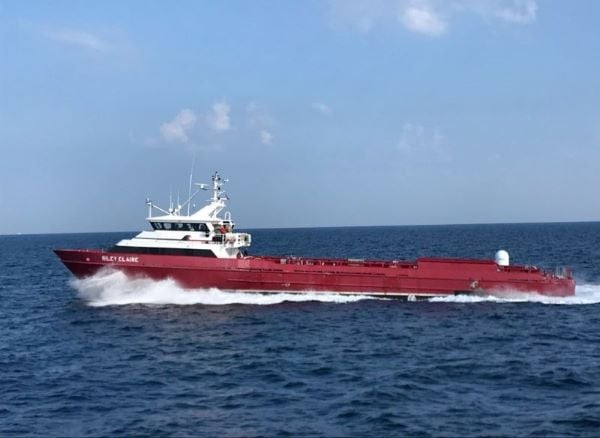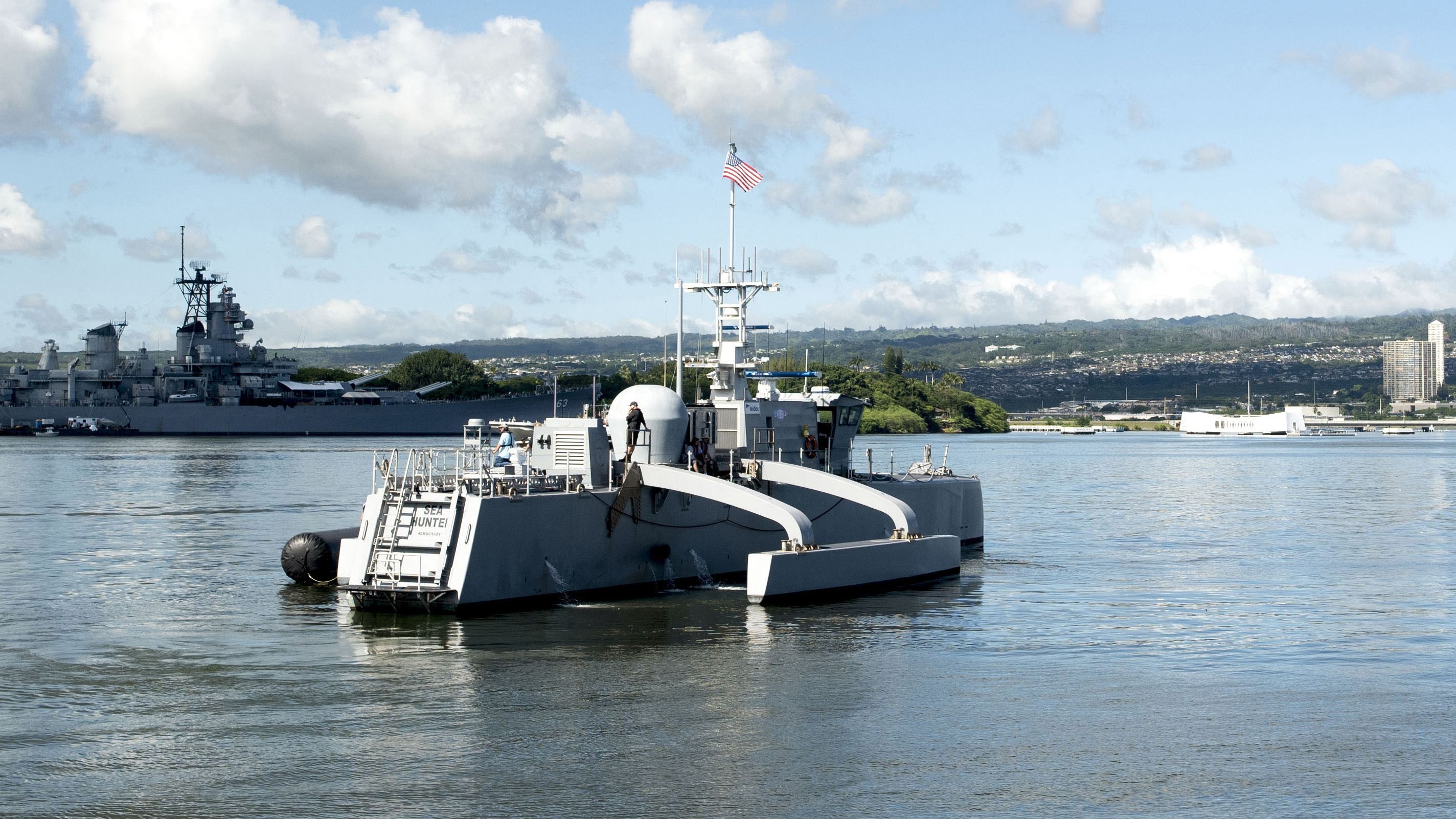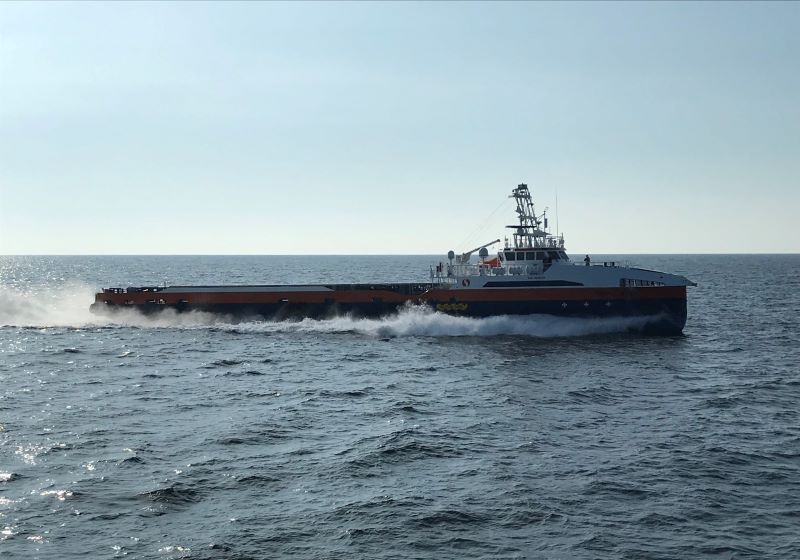
The Navy’s transition from prototype to program of record for its portfolio of unmanned surface and undersea systems is being aided by industry, international partners and developmental squadrons, even as the program office seeks to ease concerns that the transition is happening too fast, the program executive officer for unmanned and small combatants said today.
Rear Adm. Casey Moton said he’s aware of concerns regarding how unmanned systems – particularly the Large Unmanned Surface Vessel – will be developed and used by the fleet, but he’s confident in his team’s path forward.
“From my standpoint we are making a lot of great progress in working out the technical maturity, answering those kinds of questions (about how to employ and sustain the vessels) and getting the requirements right before we move into production,” he said in a virtual event today co-hosted by the U.S. Naval Institute and the Center for Strategic and International Studies.
Among the hurdles the LUSV faces is pushback from Congress. Lawmakers were first concerned about an unmanned vessel that would carry missiles – and whether the Navy was ready to protect the craft from being sunk, sabotaged, stolen or hacked. Concern then turned to the pace at which the Navy wants to move, with Pentagon-level prototyping tests taking place now, the Navy taking over the testing in Fiscal Year 2021 and then competing a contract for the first program-of-record LUSV in FY 2023.
This week, the House Armed Services Committee released parts of its FY 2021 National Defense Authorization Act legislation, which bans funding to buy any LUSVs until the Navy can certify that the subsystems are mature and reliable, that the command and control and autonomy are reliable, that measures are in place to measure and demonstrate ongoing performance, and more. The seapower and projection forces subcommittee language will be in the full bill set for a markup and vote next week.
A committee aide told reporters on Monday that, “if you look at their acquisition strategy, there’s really no gap in between what they’re calling these prototype ships and when they go into actual serial production. So essentially they’ve been trying to go into serial production from the very beginning. We don’t believe that that’s a sound strategy. Certainly prototyping is a good idea, and when we asked what they could do with six that they can’t do with four, we didn’t get any detailed answers on that other than, well we can get a lot more steaming hours. Well, that doesn’t tell me that you really need that many.”
Without directly referencing the committee or the bill, Moton said during the event that, “for LUSV, we don’t buy our first program-of-record prototype until FY ‘23. The FY ‘23 vessel, which our plan is would have [Vertical Launching System cells], is going to be quite a bit different from the prototypes. I think there’s folks out there that believe that our prototypes are the start of a serial production run. I don’t believe that’s true. Our prototypes are out there to [increase] technical maturity, and then when we are through that work and we have everything matured, we will buy our first vessel in FY ’23.”

The two prototypes in the water today, Overlord USVs purchased by the Pentagon’s Strategic Capabilities Office, are converted manned commercial fast supply vessels that went through an overhaul period to install autonomy systems to control ship navigation and operations. The Navy was given research and development money this current fiscal year to buy two more LUSV prototype vessels and wanted money in FY 2021 for two more. It would then buy one more in FY 2022 with R&D funding before starting the program-of-record acquisition program with shipbuilding funds in FY 2023. It is not clear when the requirements would have to be set to allow for a competitive acquisition program and a contract award by the end of FY 2023, and therefore how much of the prototyping effort would be able to inform those requirements.
Lawmakers would rather see a clearer path from learning through prototypes, to taking that knowledge and writing a set of requirements based on that, to buying and building a LUSV that has made the most of the prototyping period.
“What we really need to see is that they have a full understanding of what the requirements are to then go and confidently build a ship that they’re confident in the design and it’s going to meet what their requirements are,” the HASC aide said this week.
“Right now I feel like they’re wanting to build ships to figure out what the requirements are, which is the opposite of the way they should do.”
A second line of concern from lawmakers has to do with the reliability of the components of the LUSV. The Navy’s plan for the LUSV is that it could operate for at least 30 days and potentially up to 90 days without human intervention – a far cry from the daily maintenance the Navy conducts on manned ships, with sailors constantly painting, tending to the engines, checking on pipes and more.
“There are a lot of concerns about that; I’m not saying that there’s not work to go, but it’s an area that we’re focused on very hard,” Moton said of the hull, mechanical and electrical systems that will make up the LUSV.
“Both of our vendors with our Overlord vessels right now have HM&E system with reliability features, with autonomy features, and a lot of these features are not super developmental. The fundamentals – the generators, the engines, the fuel filters –a lot of that stuff is normal, good, robust commercial gear, the same kind of commercial gear that’s operating with high reliability on offshore support vessels on offshore platforms. What we’re doing is automated valves; maybe redundancies, so if one system fails there’s a second one; sea chests that can do some automated cleaning; you might have one fuel filter and we’ll have two fuel filters. And then honestly the control piece of that as well, which we are testing heavily and are going to do some additional testing at our Naval Surface Warfare Center in Philadelphia. So HM&E autonomy is something that’s a big focus for us. We feel confident that the 30-day threshold requirement is something that’s achievable. We worked really hard with industry on that number and are confident based on what we’ve gotten back and our performance to date that we’re going to be able to meet that requirement.”
Moton noted that an Overlord vessel recently traveled from the Gulf Coast to Norfolk, Va., and back – a 1,400 nautical mile journey – while autonomously navigating and following International Regulations for Preventing Collisions at Sea (COLREGs) to safely operate among commercial traffic. This follows a previous mission by a Sea Hunter medium USV from San Diego to Hawaii and back, where the vessel needed small mechanical repairs on the way out but made the trip home without intervention.

As for what maintenance would look like when the LUSV and the Medium USV require it, that’s still being discussed.
USNI News recently reported that the Surface Development Squadron One (SURFDEVRON) was working on the first iteration of a concept of operations document for the surface fleet, which would not only include how the LUSVs and MUSVs would perform missions but also what manning they would require, how maintenance would be done, where they would be controlled from and more. SURFDEVRON has just one Sea Hunter prototype originally purchased by DARPA, but as a second Sea Hunter and the two Overlord vessels come into their command, they will start experimenting at sea to refine the initial CONOPS.
“From my standpoint, we definitely, like any program office, we are responsible for sustainment of the systems, so we have all the steps in place to work that out. For USVs in particular, there is a lot of interesting questions we’ve got to decide on: do we keep those vessels under the maintenance employ of our traditional surface combatant maintenance force, with the [regional maintenance centers] and all of that infrastructure? Do we treat them perhaps more like aircraft, where a squadron is participating and the squadron does [operational]-level maintenance? How do we handle the [intermediate] maintenance and the [depot] maintenance of these? We don’t precisely know” all the answers yet, he said, but the PEO is relying heavily on the SURFDEVRON to make their best recommendations for the fleet and for the program office back at Washington Navy Yard.
Finally, Moton said he has the benefit of allies and partners going through the same growing pains with unmanned systems. NATO has invested in research into unmanned vessels and surface gliders to support anti-submarine warfare, mine countermeasures and other mission sets, and NATO members and other partners around the world are turning to unmanned systems in all domains to extend their reach while keeping down costs.
Moton noted that NATO had stood up a Maritime Unmanned Systems (MUS) initiative and hosted a Recognized Environmental Picture (REP) MUS 2019 exercise last year off Portugal, which Moton was able to attend. He said he was impressed with what he saw during the exercise’s demonstration day.
“There are just so many countries out there that are bringing [unmanned systems] all the way from smaller UUVs to medium-sized UUVs to the smaller USVs with platforms. A lot of great effort, and this NATO committee among others is helping us participate and work with other countries,” he said.
“The U.K. has done quite a bit of work there. We’ve been involved working with the U.K. on the command and control side, how to test together on unmanned vessels. From my own standpoint we’ve had a lot of great discussions with some of our closest partners – the U.K., Australia, Canada, New Zealand, others. … It’s actually not just been on the platform side but even on vessel integration. Integration of smaller unmanned systems onto ships and submarines is a hard problem, and when you talk to other countries, it’s a hard problem for them too. We’ve also got a group that’s stood up between us that’s looking at platform integration type aspects, so I think there’s a really huge opportunity there to leverage off of each others’ work and to make sure that our systems are able to operate together.”





